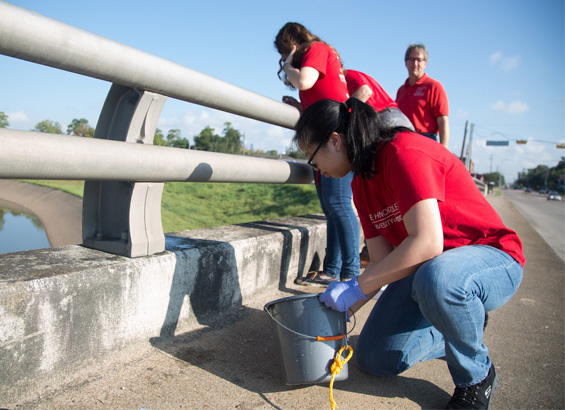Eager to help after Harvey, student volunteers from the University of Houston and University of Houston-Downtown, are collecting surface water samples from area bayous to test levels of contamination. Tens of millions of gallons of raw sewage reportedly spilled into communities and waterways when Harvey wreaked havoc on southeast Texas.
 Armed with sterile containers, gloves, and training provided by the Houston Health Department, the students are collecting samples twice a week for at least the next month to assist the health department’s ongoing collection efforts. While the city routinely checks 133 different sites once every month, this effort drastically increases the frequency of testing in targeted locations.
Armed with sterile containers, gloves, and training provided by the Houston Health Department, the students are collecting samples twice a week for at least the next month to assist the health department’s ongoing collection efforts. While the city routinely checks 133 different sites once every month, this effort drastically increases the frequency of testing in targeted locations.
“The fact that our waterways are contaminated with E. coli could point to other problems with infrastructure. If we know where those higher levels are, it will guide us to better protect our water sources and develop solutions,” said Dan Price, UH Honors College professor of data analytics in student hands, who leads the UH team. “We need to find out how quickly the contamination levels are changing and why.”
To cover more ground, some students will be collecting samples during their morning commute to campus. Isabelle Nguyen, a biomedical sciences major at the UH Honors College, calls it an interesting research and volunteer opportunity.
“It’s not a usual research project where you’re in a lab and just mixing chemicals. This gets us outdoors to see the problem first hand,” she said.
 By comparing levels of pollution at specific locations more frequently, health officials can better identify sources of contamination or leaks in pipes leading to faster remedies.
By comparing levels of pollution at specific locations more frequently, health officials can better identify sources of contamination or leaks in pipes leading to faster remedies.
“After Harvey we just have so much water in so many places and we couldn’t move simultaneously to all those locations,” said Loren Raun, chief environmental science officer, Houston Health Department. “When students are actually working on real problems with real data, it’s very motivating and helpful.”
Price believes these measurements will play an important role in determining what public health risks remain after Harvey, but also what types of interventions are needed to prepare for future flooding events or hurricanes. He hopes this initiative leads to a broader research project at UH.
“Universities have to be forward looking and can only be forward looking by using the science. We must ask how to intelligently approach this long term so we don’t have the same problems in the future,” said Price.
 The student volunteers signed up through UH CARES (Cougar Assisted Relief Efforts) created by the UH Honors College, designed to help in the massive cleanup effort following Harvey. So far, more than one hundred students have signed up and are now working as teams on various relief projects, including the water quality testing. Dean William Monroe believes the initiative is sustainable long term, even after the Harvey recovery is over.
The student volunteers signed up through UH CARES (Cougar Assisted Relief Efforts) created by the UH Honors College, designed to help in the massive cleanup effort following Harvey. So far, more than one hundred students have signed up and are now working as teams on various relief projects, including the water quality testing. Dean William Monroe believes the initiative is sustainable long term, even after the Harvey recovery is over.
“We hope two, three, five years down the road UH CARES will continue, and the city will continue to see all the great things that UH teams are doing,” he said.